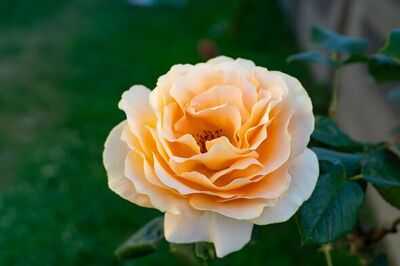
Autumn and winter can provide the perfect conditions for the dreaded rose black spot. The fungal condition can be unsightly and even severely weaken your plants.
Rose black spot is caused by a fungus called Diplocarpon rosae. The pathogen causes purple or black spots to develop on the leaves. This causes premature leaf drop and often happens from spring onwards.
Fortunately, gardening expert Monty Don has shared some crucial advice on how to manage this fungal disease effectively.
Monty's best trick to deal with these pesky black spots involves watering your roses in a very specific manner. Warm and damp conditions are ideal for encouraging the disease. While you can't stop the rain, Monty advises that one of the only practical things you can do is "don't water overhead."
In addition to urging gardeners to keep the leaves dry, Monty explains what to do with affected leaves.
"Don't wet the leaves, keep the leaves dry, so water at the base. Gather up all the affected leaves that drop and burn them. Don't put them on the compost heap. And then in winter, rake the ground around the plant thoroughly to disturb the source. Leave it bare over the winter months, then mulch it quickly in early Spring." The cold will affect the spores that will be in the ground.
The gardening expert emphasises that when it comes to dealing with black spot, "it's really a question of how much you can tolerate". However, "if it's defoliating completely, if the plant is suffering and looking bad, and other roses near it are not suffering from it, then that's because the plant is particularly prone to it."
In this case, he advises to just "get rid of it, get another."
Ironically, rose black spot has increased in prevalence, despite the UK air getting cleaner. In the BBC Gardeners' World Magazine Podcast, the "nation's head gardener" explained that until the late 1950s and early 60's, it was much less prevalent because the air was dirtier - there was much more sulphur in the air, and sulphur is a way of curing black spot.
Other gardening experts echo Monty's advice and even explain what you can do on a soil level.
Tracey Bull, RHS Plant Health Adviser, says "we all love roses and can't resist their fragrance, yet however hard you try, you're likely to come across a disease called Rose Black Spot''
"It's a fungal disease that thrives in warm and wet weather. So healthy roses are more disease resistant, and the most important thing is the soil you have for your roses."
"They like deep, fertile, well-conditioned soil. And particularly clay soils. So to improve your soil, add a generous layer of mulch in late winter."
This helps improve the structure of the soil, retain moisture, and cover fungal spores, preventing them from spreading.
You may also like

Maharashtra: Massive fire engulfs godown in Bhiwandi, no injuries reported

Tripura: Girl raped, poisoned in Agartala; accused arrested

Cuttack clashes: Police deny bike rally permission; 25, including eight officers injured in violence

Gary Neville urges England be 'a team again' amid flag rows and rising tensions

'That's ridiculous' - Jamie Carragher offers reaction to Chelsea celebrations after Enzo Maresca sent off







